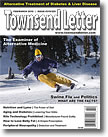 Navigating the most appropriate diet for a Lyme disease patient can be difficult, but good nutrition is such a crucial part of any treatment regimen that it is well worth addressing. Lyme disease is an illness caused by bacteria that is typically transmitted via ticks, but may also be spread via lice, fleas, mosquitos, and other insects. Many Lyme-literate physicians and researchers also believe that Lyme disease can be transmitted sexually, and from mother to baby in utero. Navigating the most appropriate diet for a Lyme disease patient can be difficult, but good nutrition is such a crucial part of any treatment regimen that it is well worth addressing. Lyme disease is an illness caused by bacteria that is typically transmitted via ticks, but may also be spread via lice, fleas, mosquitos, and other insects. Many Lyme-literate physicians and researchers also believe that Lyme disease can be transmitted sexually, and from mother to baby in utero.
Lyme disease is the fastest growing vector-borne disease in the country. It is prevalent nationwide, not only in the New England states, as public perception might indicate. There are also coinfections that tend to occur with Lyme disease itself, such as Borrelia, Bartonella and Ehrlichia. These coinfections further complicate the treatment regimens for Lyme disease patients, as different remedies, both herbal and pharmaceutical, should be used for different infections.
Acute Lyme can be adequately dealt with, if caught early and treated aggressively enough. Chronic Lyme, however, can be more problematic. First, many people go undiagnosed for years, living with a host of debilitating symptoms such as extreme fatigue, joint and muscle pain, neurological symptoms such as numbness/tingling of the hands and feet, shooting pains, severe headaches, and memory/concentration problems. Depression and anxiety are very common comorbidities in tick-borne illness. The brain fog that Lyme sufferers describe is horrible – many have to give up their jobs and cannot carry out basic activities of daily living because of their cognitive deficits alone.
Secondly, treatment for Lyme is controversial. The Infectious Disease Society of America (IDSA) published treatment guidelines that mandate only a couple of weeks of antibiotics in treating any Lyme infection. The International Lyme and Associated Disease Society (ILADS) take a different view. They believe that chronic Lyme disease may require long-term antibiotics, often for months or even years, to get under control. The naturopathic approaches to Lyme disease and associated tick-borne illness include herbal medicines, homeopathic remedies and nosodes, nutritional support, immune support, detoxification protocols, and other natural antimicrobial approaches. Some people find bioenergetic treatments and hyperbaric oxygen therapy to be useful.
I believe that maintaining optimal nutrition is crucial for Lyme disease sufferers, but there is limited information on what people should eat, and how diet affects the disease process in Lyme.
My new book, The Lyme Diet: Nutritional Strategies for Healing from Lyme Disease, was born out of this desire to assist people in their nutritional choices.
There are several major tenets of the Lyme Diet. The major benefits of eating this way are:
1. reducing inflammation in the body
2. supporting the immune system
3. preventing candida and supporting healthy digestive function
4. supporting hormone systems
5. supporting detoxification
The book outlines many different food choices and how they contribute to these goals. Two of the major and more obvious categories of foods to be avoided are gluten and sugar, and these will be discussed here. But there are also many other factors that are discussed, such as eating for glycemic control, the benefits of an alkaline diet, and how a high-oxalate diet can affect pain and fatigue.
Gluten-Free Eating
There are many reasons to avoid eating gluten. Many Americans are gluten intolerant and do not even realize it. The most severe form of gluten intolerance – celiac disease – may present with severe diarrhea, abdominal pain, skin conditions, and weight loss; however, there are many other signs of gluten intolerance that may not be so obvious, such as low-grade digestive issues, gas, bloating and heartburn, decreased energy, joint and muscle pain, headaches, and skin rashes. Many of these symptoms overlap with Lyme symptoms and indicate inflammation in the body.
Gluten is pro-inflammatory. Gluten molecules can actually trigger an immune response, partially as they are not well broken down by deficient enzyme systems, and largely because many people have an autoimmune response to them. What this means is that the molecule triggers the immune system to attack the body's own tissues. Any immune response releases chemical mediators that cause inflammation and lead to symptoms such as pain, edema, and headaches.
Being that Lyme disease creates such a high level of inflammation in the body, removing any additional sources of inflammation is important, and this is largely why a gluten-free diet is so critical. It also removes a source of immune activation, given that the immune system is already so taxed dealing with the infections themselves.
Low Sugar/Carbohydrate Diet
One of the first things I do with my Lyme patients is some kind of antifungal treatment, and I commonly find that people get some rapid improvement after doing this, particularly in cognitive symptoms such as memory and concentration. This positive response leads me to believe that yeast overgrowth, particularly candidiasis, is a contributing factor in many Lyme patients' symptomatology. Add to that the impact of long-term antibiotics on the intestinal flora, and there is a major argument for keeping a keen eye to preventing yeast.
Adequate probiotics (up to 200 billion organisms per day), and natural antifungals such as pau d'arco, garlic, oregano, and caprylic acid are great adjuncts. However, a key factor is keeping sugar and carbohydrate intake low.
Sugar feeds yeast. It is as simple as that. If we are trying to deprive yeast of its food source, we need to keep the sugars and carbohydrates away from it. Feeding the yeast with sugars allows it to flourish.
Which carbohydrates are good and which are not so good? While all carbohydrates ultimately break down to simple sugars, there are good choices you can make. Simple sugars, such as refined white sugar in cakes and cookies, are about the worst. Those foods have very little nutritional content and are also a source of saturated fats and gluten. More complex carbohydrates such as cereals and flours can still feed yeast, as the body breaks them down to simple sugars. Fruits, while considered healthy by virtue of their vitamin and mineral content, can still feed yeast and should be restricted in Lyme patients, especially those with known yeast overgrowth, and those on antibiotics.
The carbohydrates that I suggest people eat come from vegetables such as broccoli, leafy greens, and salads. These foods are health-giving, come directly from nature, and are full of vitamins, minerals, and enzymes. They also are high in fiber, which slows their transit through the intestines and provides roughage to ensure healthy bowel movements.
Another thing that many people do not realize is the impact of sugar consumption on the immune system. One teaspoon of sugar has been found to suppress immunity for up to 16 hours. So if a person eats a high-sugar diet, his immune system is never working at full steam. The bacterial infection of Lyme disease is already known for suppressing the immune system, so it is important that we do not make food choices to further that detrimental effect.
These are just two examples of how food can directly affect symptomatology for a Lyme disease sufferer, and how food can be used to aid the recovery process. The Lyme Diet goes into extensive detail about how to eat to balance hormones, recover the adrenals, minimize inflammation, and keep the digestive system happy in the face of extensive antibiotic regimens.
Food is medicine. It sustains us, nourishes us, and can heal us. It should be one of the most important factors in the treatment program of someone with Lyme disease. Unfortunately, even with the best intentions, many people just do not know what the optimal diet is for them. With Lyme-brain, it is almost impossible to wade through the plethora of available diets and information without becoming overwhelmed.
I believe that the body has an incredible power of self-healing. It knows what it needs to heal – sometimes we just need to get out of the way and remove the obstacles to healing. In a nutritional sense, that means taking away the foods that bring the body down and supplying it with healthy vibrant raw materials that it can use to produce strong immune cells, healthy neurons, and strong muscle fibers.

Nicola McFadzean, ND
1111 Fort Stockton Drive, Suite H
San Diego, California 92103
info@drnicola.com
Dr. Nicola McFadzean is the founder and owner of RestorMedicine in San Diego, California. Originally trained as a nutritionist and traditional naturopath in her native Australia, she later went on to complete her doctorate in naturopathic medicine at Bastyr University in Seattle, Washington. Dr. McFadzean is a Lyme-literate naturopathic doctor, and combines conventional and integrative approaches to treat tick-borne illnesses. She is a member of the International Lyme and Associated Disease Association (ILADS) and has completed the ILADS Training Program under the mentorship of Dr. Steven Harris. She is also affiliated with Dr. Yang's Family Care in Santee, California.
|



![]()
![]()
![]()

 Navigating the most appropriate diet for a Lyme disease patient can be difficult, but good nutrition is such a crucial part of any treatment regimen that it is well worth addressing. Lyme disease is an illness caused by bacteria that is typically transmitted via ticks, but may also be spread via lice, fleas, mosquitos, and other insects. Many Lyme-literate physicians and researchers also believe that Lyme disease can be transmitted sexually, and from mother to baby in utero.
Navigating the most appropriate diet for a Lyme disease patient can be difficult, but good nutrition is such a crucial part of any treatment regimen that it is well worth addressing. Lyme disease is an illness caused by bacteria that is typically transmitted via ticks, but may also be spread via lice, fleas, mosquitos, and other insects. Many Lyme-literate physicians and researchers also believe that Lyme disease can be transmitted sexually, and from mother to baby in utero.